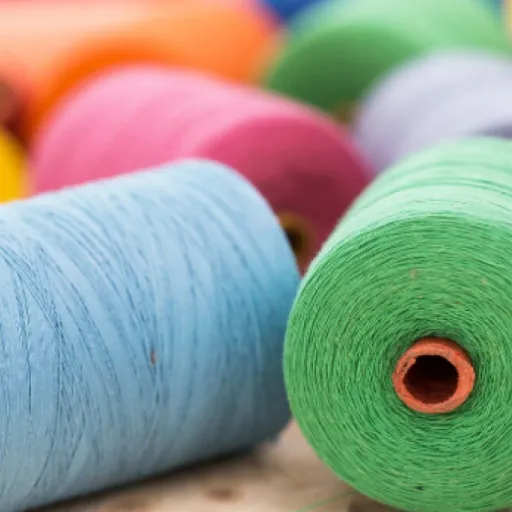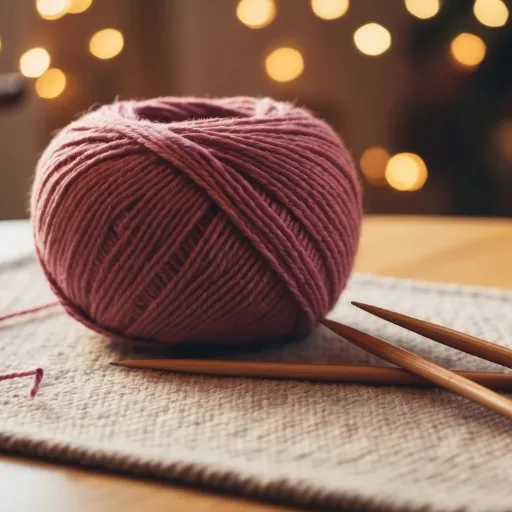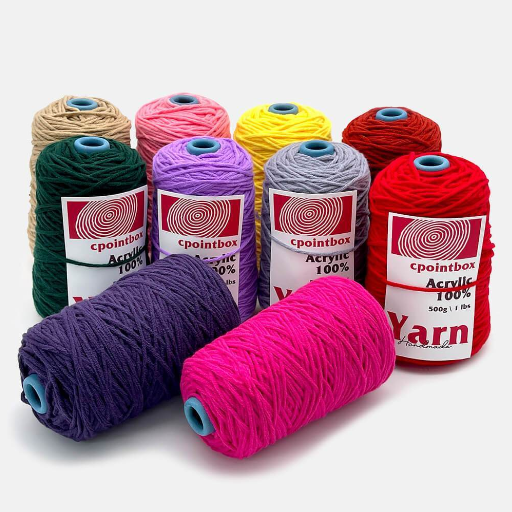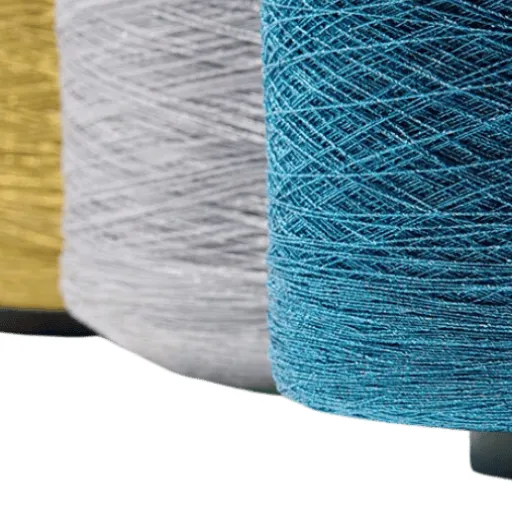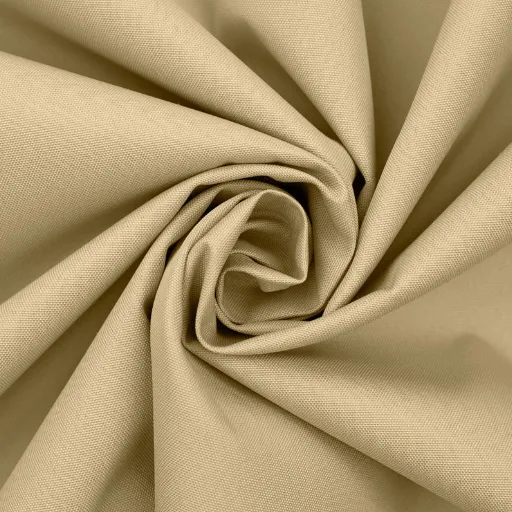Thinking about yarn for your next knitting or crochet project? Budget-friendly options will immediately catch your attention, such as polyester, acrylic, or other synthetics. But there’s more to making the right choice for your project than just price. Do you want something sturdy, delicate, or no-fuss? This article will explore the differences between multifilament and staple polyester yarn, highlighting their key traits, advantages, and optimal applications. The information is helpful for experienced crafters, beginners, and those in between, allowing you to make the best choices for your project.
Characteristics of Acrylic and Polyester Yarn
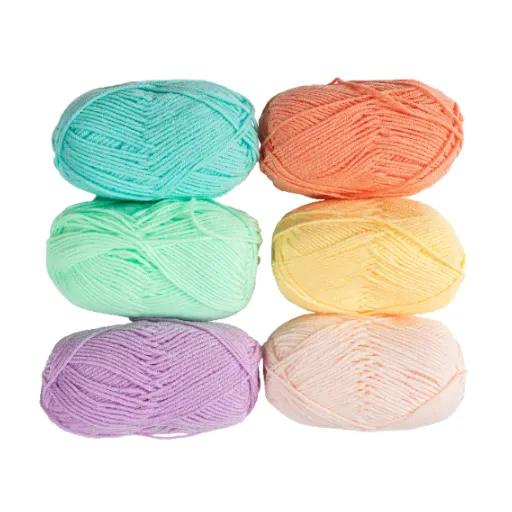
Acrylic Yarn Overview
The lightweight and affordable nature of acrylic yarn enables its widespread availability. It is delicate and soft, offering some resistance to usual wear and tear. Like most synthetic yarns, it’s low-maintenance, as it can be machine-washed and does not fade, making it especially suited for everyday use items like blankets, sweaters, and other accessories. That said, it is less breathable than natural fibers and can sometimes pill after extended use and heavy wear.
Polyester Yarn Overview
For construction yarn, polyester yarn is a synthetic brand that offers the most durability and is also resistant to stretch, shrinkage, and mildew. It is the best choice for both home decor and outdoor projects, as it is also suitable for heavy washing. The texture of polyester yarn is slightly slick and can be refined for a better feel or look by blending with other fibers. Although it is not as soft as acrylic, its sturdiness and wide range of applications make it the best choice for use.
Acrylic Yarn: Features and Benefits
One of the most widely used synthetic fibers in the crafting community is acrylic yarn. It is tender, lightweight, and cheaply priced, making it perfect for novice crafters or for use on large-scale projects. A helpful characteristic is its resistance to moths and pests, as well as its ability to maintain bright colors for an extended period. Like blankets, scarves, and sweaters, acrylic yarn is practical for day-to-day use because it is machine washable and requires minimal care. Compared to wool and other natural fibers, it has low breathability, which may decrease comfort in warm-weather apparel. Despite this, hobbyists and professionals use it widely and fondly, as it is versatile and economical.
Polyester Yarn: Properties and Advantages
Polyester yarn is a man-made fiber polymer that is notably strong and resistant to stretching and shrinking. It is extremely shape-retaining, even after prolonged use. This type of yarn is used in the production of apparel, furniture, industrial products, and a variety of other items. Compared to natural fibers, polyester yarn is more practical for both daily and specialized uses, owing to its moisture resistance, quick drying, and low-wrinkle properties. Multimaterial construction often mitigates its reduced breathability, especially when blended with cotton.
Comparative Analysis of Acrylic and Polyester
Based on the latest information, here’s a concise table comparing Acrylic vs Polyester:
| Parameter | Acrylic | Polyester |
|---|---|---|
| Softness | Softer, wool-like texture | Smooth, sometimes tough |
| Durability | Less durable, prone to pilling | Highly durable, resists wear |
| Breathability | Less breathable, retains warmth | More breathable, wicks moisture |
| Texture | Bulkier, mimics natural fibers | Sleek, versatile finishes |
| Applications | Ideal for warm, cozy items | Best for activewear, outdoor gear |
Durability of Acrylic vs Polyester Yarn
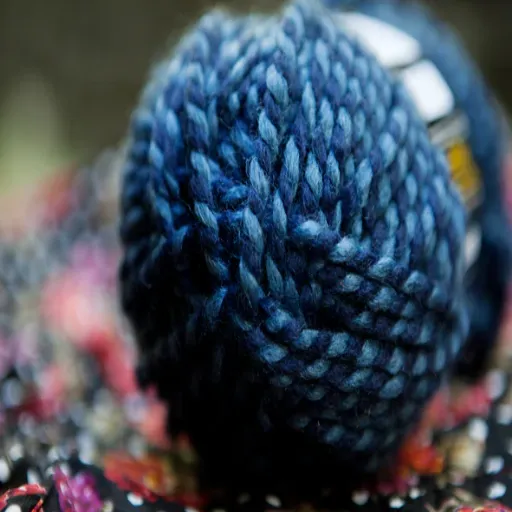
Within the sphere of textile manufacturing, the nuanced connotations of acrylic and polyester are often debated. To begin, polyester is undoubtedly more robust than acrylic. The resisting property of polyester makes it stretch less. Additionally, abrasion makes it less prone to wear, making it ideal for use in items that undergo constant and prolonged use. In contrast, the durability of acrylic is significantly lower, and it is more prone to pilling. Pilling can dramatically impact the appearance and lifespan of the completed item. As previously noted, polyester remains the best option for the project and is far superior to alternatives.
Longevity of Acrylic Yarn
Although it doesn’t last as long as polyester, acrylic yarn has a place in the crafting world, primarily due to its affordability and convenience. With proper care, acrylic yarn products can be used for years, even as pilling and general wear gradually change their appearance. Recently, users have requested tips on how to care for items made of acrylic yarn, as indicated by search metrics. Typical advice includes using gentle washing, avoiding heat while drying, and storing completed products in a place with minimal rubbing. These simple steps truly preserve the yarn and keep the projects looking good for a longer time.
Durability of Polyester Yarn
The advantages of polyester yarn include its durability and resistance to wear, making it a common choice for textile and crafting projects. According to the search engine’s most recent data, the question “How to maintain the durability of projects made with polyester?” is frequently asked. To increase the lifespan of items, experts recommend using gentle detergents on mild cycles, avoiding high heat during the drying process, and minimizing direct sunlight exposure. Such care ensures the preservation of the form and color of creations crafted from polyester yarn, enabling them to withstand everyday wear and retain their original quality.
Comparing Resistance to Wear and Tear
Although polyester is well-known and appreciated for its durability, it also requires proper care to maintain its durability. According to the latest available data, recent search trends indicate that people frequently ask about caring for polyester and extending its lifespan. Polyester, in general, is not particularly rugged to care for, and there are only a few guidelines to follow to maximize the benefits of the fabric over time. To begin with, soak and wash the clothing in cold or warm water, as polyester fibers can be injured by very hot water. Then, set the low heat or even air dry to avoid some damage to the fibers. Finally, prolonged exposure to direct sunlight is harmful and should be avoided as it can also injure the fabric. Polishing these habits can significantly aid in preserving the condition of polyester and maintaining its optimal performance in the various applications to which it is put.
Cost Comparison: Acrylic vs Polyester Yarn
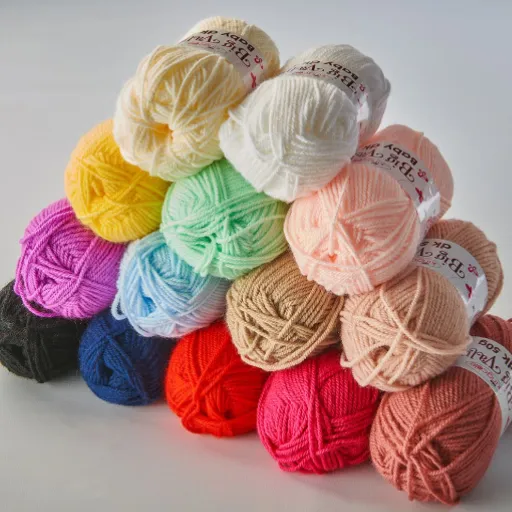
Acrylic yarn is often the most affordable option compared to polyester. This is primarily due to its lower production costs and widespread availability. Due to its versatility and durability, polyester yarn is slightly more expensive than other yarns. Although both materials suit the budget, acrylic tends to be more cost-effective, especially in projects that require a higher volume.
Affordability of Acrylic Yarn
The production method and the materials used in making a particular type of yarn determine its overall price. An example is acrylic yarn, which is synthetically produced from petroleum and is widely available and inexpensive to manufacture. Furthermore, the production of acrylic yarn in large quantities reduces production and retail costs, making it a more economical alternative for consumers. The most recent information on various searches highlights that the phrase “cheap yarn options” consistently mentions acrylic yarn as a preferred choice, especially for beginners or those with crafting projects on a tight budget. Its lower price point compared to yarns like polyester makes it considerably more versatile, and this has led to a great following worldwide.
Pricing of Polyester Yarn
Crafting and textiles often incorporate synthetic yarns, which are chosen for their long-lasting use and ability to resist both wrinkles and perspiration. According to the latest data obtained from search engines, the search term “polyester yarn prices” indicates a steady interest in this material, particularly among hobbyist professionals and dedicated crafters seeking durable materials. Polyester yarns, while always edging on the pricier side compared to acrylic yarns, tend to be more expensive for the quality that they offer: enhanced strength and superior elasticity. For sturdy, long-lasting, and even beat-resistant projects, the exceptional features offered by yarns are valued by consumers.
Value for Money in Different Applications
Polyester yarn’s steady rise in popularity is a clear indicator of the attention it is receiving from designers and hobbyists seeking material that is dependable and versatile. The question of whether or not to buy polyester yarn is, in essence, a project-based decision. For projects that require durable, elastic, and wear-resistant materials, polyester yarn is indeed the best choice. At the same time, acrylic yarn is an alternative with lower-priced yarn; materials that use polyester yield better results. Thus, polyester yarn is a worthwhile investment for projects that require premium finishing and prolonged use.
Environmental Impact of Synthetic Fibers
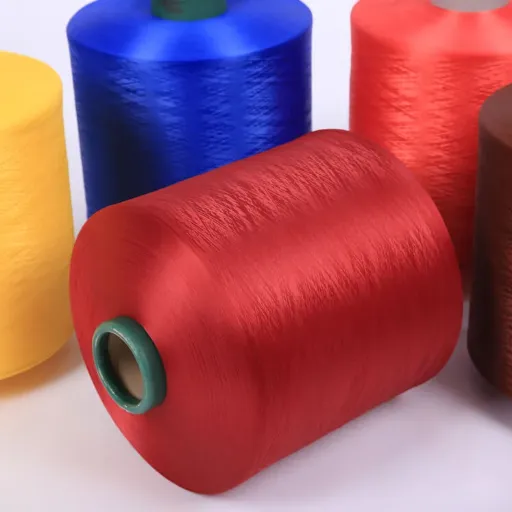
The environmental impacts of synthetic fibers are widely regarded as negative. Not only do they contribute to the depletion of non-renewable resources, such as petroleum, but the synthetic fibers production process is also responsible for greenhouse gas emissions. Furthermore, artificial fibers such as polyester are a source of microplastic pollution because they release tiny fragments when washed, which then enter water systems. To a certain extent, steps have been taken to recycle and produce eco-friendly synthetic fibers; however, the environmental impacts associated with synthetic fibers remain concerning compared to those of natural fibers.
Acrylic Yarn and Its Environmental Concerns
Due to its synthetic composition, specifically polyacrylonitrile —a plastic-like substance derived from fossil fuels —acrylic yarn is not biodegradable. Natural fibers, such as wool or cotton, break down over time when the conditions are right. In contrast to these fibers, acrylic yarn decomposes over decades to centuries. Crafting with acrylic yarn may be attractive due to its sturdiness, but it poses long-term environmental risks if disposed of improperly.
Polyester Yarn: Sustainability and Recycling
Another synthetic material often used in textiles is polyester yarn. It is made from petroleum-based polymers and is preferred across industries due to its durability and wear resistance. However, like acrylic fibers, its synthetic nature poses challenges to environmental sustainability. Polyester persists in landfills for decades as it is not biodegradable.
New recycling technologies can help mitigate the environmental issues associated with polyester. For example, rPET (recycled polyester) is made from used plastic bottles and other forms of waste, which helps decrease the need for new petroleum products. Data indicate that the global recycled polyester market is expanding, suggesting that consumers are increasingly seeking environmentally friendly products. It is not a perfect solution, but using recycled polyester in crafting and manufacturing helps lower the amount of plastic waste. Polyester and other synthetic fibers continue to pose a challenge, but they can be addressed through innovations and heightened environmental awareness.
Making Eco-Friendly Choices
Both acrylic and polyester have their pros and cons, but sweater makers should note that they are both synthetic materials. With recycled materials, polyester is slightly more eco-friendly, more durable, and softer than acrylic. The fabric is cheaper and smoother, but its production process is more environmentally harmful, and it is less recyclable than polyester and other fabrics. Woolsworth is not the refined star of either; with his whole heart, he supports recycled polyester.
Usage Scenarios for Acrylic and Polyester Yarn
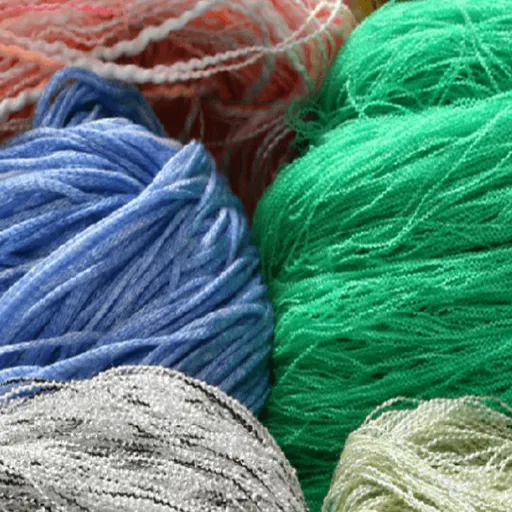
The softness, wide range of colors, and reasonable prices of acrylic yarn make it a helpful material for crafting projects such as blankets, sweaters, and scarves. It is beneficial for clothing and materials that are warm and enduring.
In contrast, the use of polyester yarn is more performance-based and suitable for outdoor applications. Athletic bags, sportswear, and outdoor gear are ideal for such merchandise, as they help wick away moisture and combat mold and mildew. Furthermore, polyester yarn is durable and strong, making it suitable for merchandise that requires withstanding considerable wear and tear.
Best Projects for Acrylic Yarn
- Warm blankets and throws
- Scarves and winter accessories
- Hats and beanies
- Vibrant amigurumi creations
- Projects for new and experienced knitters and crocheters
Acrylic yarn is an excellent choice for a wide range of projects. Its cost-effectiveness and maintenance benefits make it well-suited for warm blankets, scarves, and hats. Moreover, acrylic yarns’ shape-maintenance and color variety make them ideal for vibrant amigurumi creations. Furthermore, the gentle feel and dependable quality of the yarn make it an excellent option for both new and experienced knitters and crocheters.
Ideal Applications for Polyester Yarn
- Crafting bags and accessories
- Durable blankets for heavy use
- Outerwear and weather-resistant items
- Home décor items (rugs, curtains, upholstery)
- Athletic and outdoor gear
Because polyester yarn is stretch-resistant, durable, versatile, and widely available, it is used extensively in both household and industrial applications. Due to its stretch resistance, olive durability, and versatility, polyester yarn is brilliant for crafting bags, blankets, and outerwear. Moreover, polyester yarn is also suitable for crafting home décor items such as rugs, curtains, and upholstery, which require easy maintenance and durability. Its low cost keeps it in high demand among both creators and manufacturers.
When to Choose Each Type of Yarn
When selecting the appropriate type of yarn, it is advisable to consider the project requirements and evaluate each material’s features in relation to these requirements. Here, we highlight some of the commonly used yarns and their ideal applications. For sweaters, scarves, and socks, cotton and wool are suitable due to their natural breathability and comfort. For sturdier household goods and outdoor accessories, polyester and acrylic yarns are the most appropriate. For eco-friendly and sustainable approaches, recycled yarns and bamboo yarns are leading the market due to their adoption of green alternatives. By considering the feel, durability, and sustainability of a yarn, one can accurately identify the most suitable yarn for a project.
Reference Sources
These are three advanced academic references for verifying the quality of your publication titled “Acrylic versus Polyester Yarn.” Since these references are from an academic background, their focus is on the advanced understanding and detailing of the characteristics of these yarns:
A Research on Yarn and Fabric Characteristics of Acrylic/Wool/Angora Blends
Source: DergiPark
Description: The study of the characteristics and properties of acrylic fiber and its blends, along with associated insights on the making and usage of the fibers.
Serviceability and Washing Durability of Recycled Polyester, Wool, and Acrylic
Source: ScienceDirect
Description: The project aims to investigate the durability and sustainability of polyester, wool, and acrylic, with a focus on gaining additional knowledge about microplastics leaching.
Effects of Usage of Acrylic Yarn on Thermal Comfort and Moisture Management Properties
Source: DergiPark
Description: A detailed explanation was made on thermal comfort and moisture management capabilities of acrylic and polyester fabrics.
Frequently Asked Questions (FAQs)
What is the main difference between polyester yarn and acrylic yarn?
The primary difference between polyester yarn and acrylic yarn lies in their composition and properties. Acrylic yarn is a man-made fiber derived from acrylonitrile, while polyester yarn is made from polyethylene terephthalate, a polymer that is often more durable. Acrylic yarn is known for being soft and warm, but polyester is generally more durable and resistant to wrinkles and shrinking.
Is polyester yarn more durable than acrylic yarn?
Yes, polyester yarn is known for its superior durability compared to acrylic yarn. Polyester yarns have demonstrated superior tensile strength, making them suitable for items that require robustness, such as home textiles and outdoor wear.
How does acrylic yarn compare to natural fibers like cotton or wool?
Acrylic yarn is often less breathable than natural fibers, such as cotton or wool. While acrylic has moisture-wicking properties, it does not offer the same natural elasticity and breathability as fibers like cotton or wool. This can affect comfort depending on the project.
What are the benefits of using polyester yarn?
Using polyester yarn offers several benefits, including its resistance to wrinkles and shrinking, making it easy to care for. It is also suitable for a wide range of applications, from clothing to home textiles, and is available in a variety of colors.
Can acrylic yarn be machine-washed and dried?
Acrylic yarn is easy to care for and can typically be machine-washed and dried without damage. However, it is advisable to check the care instructions on the yarn label to ensure optimal results and maintain the yarn’s integrity.
Is acrylic yarn suitable for sensitive skin?
Acrylic yarn is often softer than polyester yarn, making it more comfortable to wear for individuals with sensitive skin. However, some people may still prefer natural fibers, such as cotton, for their breathability and hypoallergenic properties.
What types of projects are best suited for polyester yarn?
Polyester yarn is suitable for a wide range of projects, including garments, accessories, and home textiles. Its durability and ease of care make it an efficient yarn type for items that will undergo frequent use or washing.
What are the environmental impacts of acrylic and polyester yarn?
The production of acrylic and polyester yarn can have an environmental impact, as both are derived from petroleum or natural gas. However, initiatives are underway in the textile industry to create more sustainable options and recycle polyester yarns, thereby reducing environmental footprints.









